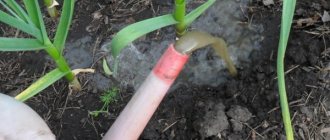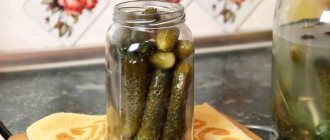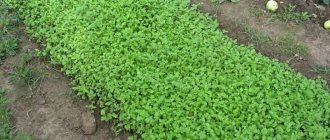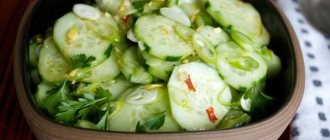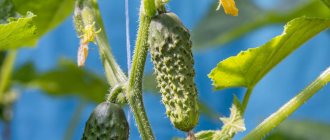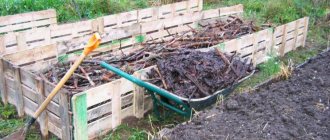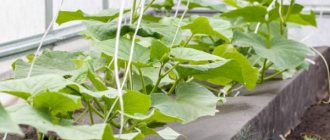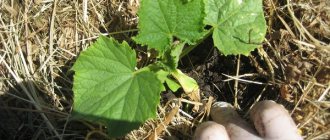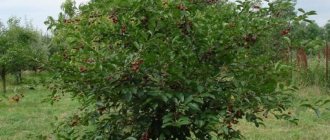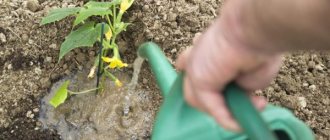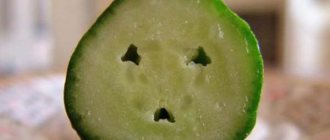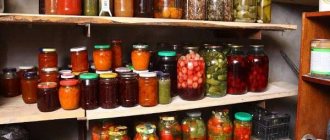In order to replenish spent substances in the soil and maintain its fertility, it is important to improve the chemical composition by adding fertilizers. Autumn is a great time to prepare for the next season. When selecting fertilizers, it is necessary to take into account the biological characteristics of the crops grown, soil properties and weather conditions. After applying fertilizers, you need to monitor the reaction of the plants, as well as the effectiveness of the combined application of several different components. Each crop requires its own nutritional regimen for optimal growth. In this article we will tell you how to choose autumn fertilizers for planting cucumbers. The soil for spring planting of cucumbers is prepared in the fall. The designated beds are dug up with manure, peat, humus or any available organic matter (kitchen waste, fallen leaves, potato peelings, vegetable tops).
Choosing a site for cucumbers
To get a good harvest of cucumbers, you need to choose the right site for sowing them. The crop is quite demanding in terms of soil and air humidity, as well as light and elevated temperatures, so beds for cucumbers should be laid out in places protected from piercing winds, without shading.
Areas with low relief - lowlands - should be avoided, as cold air flows into them. The best soils for growing cucumbers are loamy and sandy loam.
What to put in the hole for a generous cucumber harvest
Every experienced gardener knows how whimsical and capricious the cucumber is on the plot. Only with comprehensive care and compliance with the rules when planting and growing can you achieve a generous harvest of this crop. The key to a rich harvest is the application of fertilizers to the hole before planting cucumbers. It is necessary to take a responsible approach to preparing the beds where cucumbers are supposed to be planted.
Each gardener, taking into account climatic conditions, the soil on the site and personal experience, chooses which fertilizer to give preference to when preparing the land. Many summer residents are inclined to believe that they need to start preparing the land for cucumbers in late autumn, after finishing the harvest. As a rule, mineral fertilizers are chosen for this; over the course of several months, with plenty of moisture, they can saturate the soil with useful substances.
Liming the soil in autumn for cucumbers
The highest crop yields are obtained in well-fertilized fertile areas with neutral or slightly increased acidity. When preparing a plot for cucumbers, it is also important to consider the acidity of the soil. For a good harvest, it should be slightly acidic or closer to neutral (pH 6.0-6.5). If the soil is acidic, then add lime during digging in the fall - 300-500 g per 1 m2 (depending on the acidity level). As dacha experience has shown, it is better to lay out cucumber beds 2-3 years after liming.
Feeding with folk remedies
Gardeners have come up with numerous folk ways to feed cucumbers after planting them in the ground. Let's look at the most popular top dressings.
Yeast
Homemade baker's yeast preparations were used by our great-grandmothers to care for plants. These are cheap and easily accessible options for anyone looking for organic gardening solutions. A popular option among amateur gardeners is to feed the cucumbers with yeast. Regular baker's yeast works great as an alternative to chemicals and is easy to make.
Baker's yeast can be used as a fertilizer to stimulate the development of the root system and accelerate growth. Yeast is rich in many substances valuable for cucumbers: carbohydrates, B vitamins, organic iron, amino acids and trace elements. They colonize plant roots and enter into symbiosis with them, while simultaneously protecting them from attacks by harmful soil microorganisms.
Yeast Fertilizer
You will need:
- baker's yeast,
- sugar,
- water for preparing fertilizer.
Water for fertilizers does not have to be pure. This can be a decoction of vegetables, potatoes, or rain water. This water contains many ingredients valuable for plants and does not contain harmful chlorine.
Preparation
Place 100 g (1 cube) of yeast in a bucket, add 1 glass of sugar and 2 glasses of water, leave for 1-2 hours. Then the yeast dissolved in sugar is poured into 10 liters of warm water. Mix thoroughly and leave to ferment for a week. A week later, the mixture after dilution (1 glass of solution per 10 liters of water) is ready for feeding cucumbers.
Yeast supplements are best used in spring and late summer. They can also be used to feed indoor cucumbers on a windowsill or window. Yeast fertilizer has a good effect on the growth of germinating seedlings, so it is worth watering the seedlings with it.
Ash
Wood ash is a valuable fertilizer. It is impossible to determine the exact nutrient content of ash. This fertilizer is not constant, its composition depends on the types of wood used.
Ash may contain:
- 30-35 percent calcium;
- 6-10 percent potassium;
- 2-4 percent phosphorus.
The proportions of individual elements can vary significantly: spruce is a rich source of potassium, pine and oak provide plants with calcium. In addition, ash contains many microelements that are important for the development of the vegetative part.
Ash can be used as mulch, but better results can be obtained by digging it into the soil (to a depth of 10-15 cm). Despite many advantages, you should not overdo it with doses of ash fertilizers, since in excessive quantities ash can cause soil salinization. The safe dose is about 1-3 kg per 100 m². Fertilizer, due to its high calcium content, largely dehydrates the substrate.
You can add ash to cucumbers in the form of liquid ash fertilizer. A glass of ash is diluted in a bucket of water and applied to the root. Application rate – 10 liters of ash solution per 2-3 sq.m. landing Apply fertilizer 2-3 times.
The best predecessors of cucumbers
According to the rules of crop rotation, the most suitable predecessors of cucumbers are:
- potato,
- onion,
- cabbage,
- tomato,
- various green manure plants (alfalfa, clover, mustard, rye, oats, etc.).
Many gardeners have adopted the method of planting cucumbers on a compost heap, which is formed with boards made of boards. The heat that cucumbers so need is produced due to the rotting of the lower layers of such a bed, and vegetables can be sown much earlier by covering them with film. Since the branches are not capable of rotting in one season, it is possible to arrange a place for cucumbers in the same place more than once, while replacing the top fertile layer of soil.
Fertilizers after sowing cucumbers
Before planting a young cucumber in a permanent place, the main beds should be prepared. The soil must be thoroughly dug up using a spade. For sowing, you need to prepare holes 35-45 cm from each other, into which you put a kilogram of rotted manure and sprinkle about 10 cm on top of the soil. Only after this, it is good to water the holes with warm water and start transplanting young cucumbers, waiting for a cool evening.
Already in a permanent garden bed, you need to water the cucumbers abundantly at least 2 times every 7 days in the evening. Adult cucumbers also need high-quality fertilizer throughout the summer. You can prepare fertilizer for feeding cucumber crops in this simple way: pour 100 liters of water into a large container, gradually adding a glass of urea and a full bucket of cow manure. Mix all this and wait for it to be ready. After just 4 days the composition will be ready for use. The consumption of this composition is 5 liters per 1 sq.m.
Knowing when and what to put in a hole with cucumbers, you can achieve a bountiful harvest.
Sources:
https://goodgrunt.ru/cucumbers/chto-dobavlyat-pri-posadke-ogurcov.html https://eda-land.ru/ogurcy/vyrashchivanie/chto-klast-v-lunku/ https://akaoray.ru /chto-polozhit-v-lunku-dlya-shhedrogo-urozhaya-ogurca/
Preparing the soil in autumn for cucumbers
Soil cultivation for cucumbers should also be carried out starting in the fall. To do this, you must first remove all residues from the previous crop, and then add 6-7 kg of manure and 8-10 g of phosphorus-potassium fertilizers per square meter of soil while digging the soil.
It is better to dig up the soil in the fall to a depth of at least 25 cm. In this case, there is no need to break up the clods. When choosing a place for cucumbers, do not forget that frost is destructive for them. Ideally, the site should be oriented to the south, this can protect the plants from cold winds.
What minerals are added before planting?
The main concern for increasing soil fertility for planting cucumbers comes in the fall: mineral and organic fertilizers need time to be completely absorbed into the soil.
For a good start, cucumbers are placed in the holes:
- Granular superphosphate, characterized by slow movement through the ground. Its close “neighborhood” with the roots of the seedlings will completely cover the need for the element. A tablespoon of simple or a teaspoon of double superphosphate is enough for one well.
- Urea, which will provide plants with the amount of nitrogen necessary for growth.
- Potassium is the main element responsible for the quality of fruits. Potassium nitrate is added to the wells, which simultaneously produces nitrogen, potassium sulfate or molybdate.
Often, instead of putting fertilizers in the holes, summer residents prefer to add them in liquid form by preparing a solution:
- potassium sulfate – 15 g;
- ammonium nitrate – 10 g;
- simple superphosphate – 10 g;
- water – 10 l.
Half a liter of solution is poured into each well.
The use of complex fertilizers simplifies the work, for example:
- Diammofoska is added at the rate of 15 k/m 2;
- ammophoska – 30 g/m2.
Application of mineral fertilizers in autumn for planting cucumbers
Plants can absorb all useful substances from the soil only in the form of an aqueous solution. Therefore, many people prefer to use liquid complex fertilizers: they penetrate to the roots more quickly and, naturally, are absorbed faster by plants. What else needs to be taken into account: mineral fertilizers applied in the fall should have a minimum nitrogen content; on the packaging of such compositions it is usually written: “autumn” or “for autumn use.” These mineral mixtures contain almost no nitrogen, but contain phosphorus, potassium, calcium - microelements necessary for the ripening of shoots, strengthening plant immunity, and increasing resistance to low temperatures. Information about the rate of fertilizer application is also available.
What does charging a hole with fertilizers do?
Cucumbers are considered a plant with a short growing season. In order for them to have time to form a powerful vine with strong foliage and a large number of female flowers and fruits in the short summer, they need fertile soil saturated with a full set of macro- and microelements.
Well and properly fertilized soil also speeds up the process of seedling adaptation in a new place; it does not linger and quickly continues its development.
Finally, warm weather encourages rapid root growth. The supply of nutrients promptly provides borage with everything necessary for the formation of beautiful, tasty cucumbers.
Applying organic fertilizers in the fall for planting cucumbers
Organic fertilizers have the most beneficial effect on the growth and development of cucumber plants. Cucumbers are very responsive to organic fertilizers. On soils well amended with organic fertilizers, the effectiveness of mineral fertilizers also increases sharply. Manure is the most valuable organic fertilizer. Turning into humus, it improves the structure of the soil, makes heavy clay soils more loose, and gives cohesion to sandy soils. Manure contains: nitrogen, phosphorus, potassium and calcium. Horse and sheep manure is richer in nitrogen and phosphoric acid, it is looser, contains less water, decomposes faster and heats up better. It is called hot manure. Cattle and pig manure contains more water and breaks down slowly. Manure is applied in two periods: the first half in the fall, for digging, and the second part (in rotted form) in the spring, when processing plowed land, or into holes when sowing seeds. On light soils, manure should be applied immediately before sowing cucumbers, before plowing or digging up the area. In heavier soils, where manure decomposes slowly, it is applied early in spring or autumn. The plots for cucumbers dug up in the fall and fertilized with organic matter are loosened in the spring. The consumption of organic fertilizers for cucumbers can be reduced several times if they are applied not under digging, but in a hole when planting seedlings or in a row when sowing seeds.
Effective organic fertilizers for cucumbers: mullein and bird droppings
Using this type of organic fertilizer gives excellent results. Cow manure can be diluted in water immediately, bird manure must “burn out”, it is very aggressive and the plants are watered with its solution very carefully, in a ratio of 1:10. To make the mixture suitable for consumption, the raw materials are filled with water and allowed to ferment for several days in sunny weather.
Chicken droppings or mullein are introduced only at the root of the bush; contact with the leaves should be avoided. Cucumbers respond well to alternating ash and manure feeding. Such fertilizers do not affect the taste and smell of ripe fruits, especially when the vines are tied to a trellis. This fertilizer for cucumbers is used when growing both in greenhouses and open ground.
Note! Pig manure is not used. It contains a high percentage of ammonia compounds that burn the root system. It is permissible to prepare weak solutions only after 2–3 years of its presence in a compost pit mixed with mullein.
Adding ash in the fall for planting cucumbers
Ash, being the residue after burning wood, is an excellent fertilizer that contains potassium and phosphorus. It is usually used as the main fertilizer in the fall, and as a top dressing in the spring and summer - during planting and growing season. Phosphorus and potassium are elements essential for plants, and ash contains them in accessible forms. In addition to the main elements, it also contains magnesium, calcium, iron and other trace elements.
The composition of the ash is determined by the raw materials from which it was obtained. Ash from deciduous trees and grass will contain more calcium, and ash from coniferous trees and the bark of deciduous trees will contain more phosphorus. Wood ash for cucumbers cannot be stored for a long time - all useful substances evaporate from it.
Proper care of cucumbers cannot be imagined without autumn feeding.
When and what to feed cucumbers
To increase the yield, it is recommended to use mineral fertilizers. An excellent choice for maintaining cucumbers in a greenhouse are mixtures based on:
- Kalia,
- Phosphorus,
- Nitrogen.
Fertilizing is carried out at least four times throughout the entire period of stem growth and harvesting.
- At the initial stage, when the shoots are just gaining strength, it is necessary to add nitrogen substances to the soil.
- During the flowering period, plants should be supported with phosphorus fertilizers.
- At the time of fruiting, nitrogen and potassium additives are added to the soil.
A common mistake gardeners make is applying too much fertilizer. It is worth remembering that a large amount of nitrogen leads to a deterioration in the quality of the fruit. To grow juicy cucumbers in large quantities, it is better to apply fertilizer in small portions.
Features of autumn care
In autumn, as in summer, cucumbers should be warm, light and comfortable in a greenhouse or open ground. But since in September the air temperature and daylight hours decrease, care includes the following activities:
- Trimming. Removing yellow, dried, old leaves and side shoots. We leave only young leaves. After pruning, more light will reach the plants and there will be strength for the formation of inflorescences and ovaries.
- Pinching. When many ovaries appear, the main vine needs to be pinched. It will stop growing upward, due to which the ripening of cucumbers will accelerate.
- Protection from diseases and pests. We spill the bushes with a solution of Fitosporin (according to the instructions) and spray with an infusion of onion peels. This procedure will protect the cucumbers from diseases and pests and saturate the bushes with useful substances.
- Increase in temperature in the greenhouse. Cucumbers love warmth, so at night and on cold September days, you can put plastic bottles with warm water in the beds under the bushes. If possible, the greenhouse can be equipped with some kind of heating devices. But make sure that they do not dry out the air, otherwise spider mites may appear on the plants.
- Harvesting. Cucumbers picked from the bush in time stimulate the growth of other fruits. Harvest regularly. By the way! You can find out how to deliciously pickle cucumbers for the winter here .
How to prepare an infusion of onion peels:
- Fill a 0.5 liter jar of onion peel with 1 liter of boiling water;
- leave for 1 day;
- strain;
- dilute until light and spray on foliage.
You will be interested to know: Cucumbers in July: planting calendar, which varieties to plant
Spring preparation for growing cucumbers in open ground
If it was not possible to fertilize the soil in the fall, in the spring, at least a week before planting the seeds, in the place of the future cucumber bed, you need to dig a ditch about 40 cm deep, fill it with rotted manure, and cover the top with a 16-centimeter layer of fertile soil, after which the soil needs to be leveled, form sides and cover with thick film.
Only old manure can be added to the soil, since fresh mullein contains highly concentrated urea and nitrogen, which can burn young cucumber shoots. When fertilizing the soil, it is important to follow the proportions recommended by farmers, since an excessive amount of droppings on the site can cause the formation of voids in cucumber fruits and a decrease in yield.
Rotted hay, fallen leaves or sawdust are excellent fertilizers that can replace manure and fully fertilize the soil when planting cucumbers. Any of these substances is introduced into the prepared groove, compacted and covered with fertile soil, on which beds can already be formed.
In cases where it is not possible to fertilize the soil in advance before sowing cucumbers, 3-4 days before planting the seeds, the ground must be sprinkled with ash mixed with superphosphate in the proportion: 2 tablespoons of fertilizer per 1 cup of ash, after which one bucket of humus is applied to the soil. and rotten sawdust. Then the treated area is dug up and watered with 3-4 liters of humate solution prepared from 1 tbsp. spoons of concentrate of this fertilizer and 10 liters. water. This amount of fertilizing is enough to treat 1 square. meter of garden. After all manipulations, the soil is covered with a film to warm the earth.
In addition to replenishment made by gardeners themselves, ready-made complex fertilizers based on phosphorus and nitrogen, such as ammophos or diammophos, are also used. Due to their high mobility in the soil and easy solubility, phosphorus-nitrogen growth stimulants can be applied immediately before planting cucumbers.
Diammophos is suitable for fertilizing cucumbers before planting
Methods of fertilizing
There are 2 ways to feed cucumbers: root and foliar. The first type involves applying fertilizer directly to the roots, the second involves spraying the necessary substances onto the leaves and stems. Root feeding of cucumbers gives the best results in warm weather, when the root system develops intensively and absorbs nutrients well.
Foliar feeding of cucumbers is more suitable for cool summers, when the root system is not so effective at absorbing minerals.
Fertilizing by any method should be done in the evening in cloudy weather, so that excess sunlight does not result in burns for the plants.
It is recommended to apply fertilizer at the root after it has rained or after good watering.
What does a plant need for normal growth?
There are a large number of fertilizers on store shelves, but it is impossible to accurately determine whether they will bring a positive result. The exact recipe that is most suitable for feeding cucumbers has not been determined. Of particular importance in the procedure are the plant variety and soil characteristics.
Each period of vegetable development requires a special approach. Therefore, feeding cucumbers in a greenhouse is carried out with various fertilizers, including:
- nitrogen is most needed during the growing season;
- potassium - with the growth of lashes;
- nitrogen - during the fruiting period.
The soil in which the cucumber will grow will also help determine what additives to use.
Sandy soil usually needs potassium, boron and copper. Soddy-podzolic – nitrogen and phosphorus; peaty, alkaline, carbonate - manganese.
Potassium
Often fruits lacking this element narrow at a short distance from the stalk, the leaves turn yellow, then turn brown and wither.
Potassium sulfate (aqueous solution) or wood ash diluted in water will help solve this problem.
Nitrogen
The leaves become small and light, turn yellow and fall off. The roots die and plant growth slows down. Flowers and ovaries die. The fruits are pointed and hooked, turn yellow and spoil. The plant urgently needs nitrogen.
In this case, you can use not only chemical fertilizers, but also natural ones. It is necessary to collect any weed, chop it finely and add water (2 kg of plants per 10 liters of liquid). Leave the resulting mass until fermentation (about a week), after which you feed the cucumbers.
To maintain a normal amount of nitrogen, you can use chicken manure.
Magnesium
With a lack of this microelement, light green spots appear on the leaves. Later the foliage turns yellow, breaks and falls off.
How to improve productivity?
We are constantly receiving letters in which amateur gardeners are worried that due to the cold summer this year there will be a poor harvest of potatoes, tomatoes, cucumbers, and other vegetables. Last year we published TIPS on this matter. But unfortunately, many did not listen, but some still applied. Here is a report from our reader, we would like to recommend plant growth biostimulants that will help increase the yield by up to 50-70%.Read…
Calcium
Calcium deficiency leads to slower plant growth and premature aging of the root system. Young leaves develop yellow spots, while older leaves turn dark green on top and purple underneath. In addition, they become small and crooked. Cucumbers grow small and lack flavor.
Bor
A lack of boron leads to the cessation of fetal development and, as a consequence, to distortion of its shape. Photosynthesis is suppressed and an outflow of carbohydrates occurs, as a result of which the flowers lose their ability to fertilize and fall off. The stems are shortened, the leaves become spoon-shaped.
Phosphorus
When a plant lacks phosphorus, its leaves become small and dark green with a purple tint.
In this case, a solution of ammophos or diammophos is used.
Iron
If there is a lack of iron in the plant, chlorophyll ceases to form. The vegetable grows slowly, the leaves acquire a light green color, sometimes becoming almost white.
Important to remember
For planting cucumbers, it is better to choose slightly shaded garden plots. The soil allocated for planting this crop should be thoroughly fertilized and heated with film. Seeds must be pre-soaked and subjected to disinfection treatment to avoid the development of various diseases.
Remember, cucumbers “love” phosphate and nitrogen fertilizers, as well as abundant watering.
Tasty and healthy cucumbers, being far from being the most demanding vegetable crop, have special requirements for the composition of the soil, or more precisely, for the content of useful substances in it. For this reason, feeding cucumbers with fertilizers is an integral part of caring for this plant. The lack of one or another mineral or trace element will certainly affect the appearance of the plant - plaque will appear on the leaves, they will turn yellow and dry out, the fruits will have a deformed shape. To prevent this, it is necessary to apply fertilizers in a timely manner, and the time to do this is at the planting stage.
Excess fertilizer
When feeding cucumbers, you must be careful. You should never exceed the dose of fertilizer. If there are too many of them, the appearance of the plant will tell you about it.
Excess nitrogen - the plant develops thick, irregularly shaped stems. The leaves take on a dark green color.
Excess potassium - mosaic spots or a light yellow border appear on the leaves, which over time becomes brown and then black.
A lot of potassium leads to the formation of a mosaic structure in the leaves.
If there is an excess of phosphorus, the plant turns yellow and the leaves fall off.
Along with chemical fertilizing, you can use rotted garbage, manure, straw, sawdust, peat and manure.
